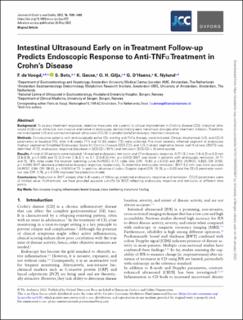| dc.description.abstract | Background
To assess treatment response, objective measures are superior to clinical improvement in Crohn’s disease [CD]. Intestinal ultrasound [IUS] is an attractive, non-invasive alternative to endoscopy, demonstrating early transmural changes after treatment initiation. Therefore, we investigated IUS and contrast-enhanced ultrasound [CEUS] to predict [early] endoscopic treatment response.
Methods
Consecutive patients with endoscopically active CD, starting anti-TNFα therapy, were included. Clinical, biochemical, IUS, and CEUS parameters at baseline [T0], after 4–8 weeks [T1] and 12–34 weeks [T2] were collected. The most severely inflamed segment at endoscopy (highest segmental Simplified Endoscopic Score for Crohn’s Disease [SES-CD]) and IUS (highest segmental bowel wall thickness [BWT]) was identified. At T2, endoscopic response [decrease in SES-CD ≥ 50%] and remission [SES-CD = 0] were scored.
Results
A total of 40 patients were included: 14 reached endoscopic remission and 17 endoscopic response. At T1 (3.1 mm [1.9–4.2] vs 5.3 mm [3.8–6.9], p = 0.005) and T2 (2.0 mm [1.8–3.1] vs 5.1 [3.0–6.3] mm, p = 0.002) BWT was lower in patients with endoscopic remission. At T1 and T2, 18% (area under the receiver operating curve [AUROC]: 0.77; odds ratio [OR]: 10.80, p = 0.012) and 29% [AUROC: 0.833; OR: 37.50, p = 0.006] BWT decrease predicted endoscopic response, respectively. To determine endoscopic remission, BWT 3.2 mm was most accurate [AUROC: 0.94; OR: 39.42, p < 0.0001] at T2. In addition, absence of colour Doppler signal [OR: 13.76, p = 0.03] and the CEUS parameter wash-out rate [OR: 0.76, p = 0.019] improved the prediction model.
Conclusions
Reduction in BWT, already after 4–8 weeks of follow-up, predicted endoscopic response and remission. CEUS parameters were of limited value. Furthermore, we have provided accurate cut-offs for BWT reflecting endoscopic response and remission at different time points. | en_US |

